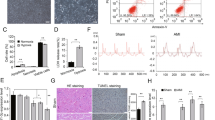Abstract
Ischemic injury in the heart is associated with low oxygen, leading to the damage of cardiomyocytes. The lncRNA-XIST is known to involve in post-ischemia myocardial remodeling. However, the roles and mechanism of XIST in the hypoxia-induced cardiomyocyte are still under investigation. Moreover, studies that elucidated the impaired glucose metabolism present new hallmark of ischemic cardiovascular injury. The objective of this study is to investigate the effects of lncRNA-XIST on cardiomyocyte injury under hypoxia. Here, we demonstrate that the XIST expressions of cardiomyocyte line, H9c2 were apparently suppressed by long-time hypoxia exposure under low glucose supply. On the contrary, miRNA-125b showed reverse expression pattern to XIST. We identified that XIST functioned as a ceRNA of miR-125b to downregulate its expression in both cell line and rat primary cardiomyocyte. Under low glucose supply, H9c2 cells exhibited increased susceptibility to hypoxia. We observed overexpression of XIST significantly elevated glycose metabolism rate under hypoxia, but overexpression of miR-125b inhibited glycose metabolism rate of cardiomyocyte under hypoxia. The glycolysis enzyme, hexokinase 2 (HK2) was validated as a direct target of miR-125b, which binds to the 3′-UTR region of HK2 mRNA in cardiomyocytes. Moreover, inhibition of miR-125b significantly protected the hypoxia-induced cardiomyocyte injury through restoration of glucose metabolism. Finally, we demonstrated that transfection of miR-125b in lncRNA-XIST overexpressed H9c2 cells effectively abolished the XIST-activated glucose metabolism and cardiomyocyte protection under hypoxia. The present study illustrates roles of the XIST-miR-125b-HK2 axis in the hypoxia-induced cardiomyocyte injury and proposes that maintaining glucose metabolism might be an effective approach for protection of cardiomyocyte injury.






Similar content being viewed by others
References
Azzouzi HE, Leptidis S, Doevendans PA, De Windt LJ (2015) HypoxamiRs: regulators of cardiac hypoxia and energy metabolism. Trends Endocrinol Metab 26:502–508
Chen H, Wang X, Yan X, Cheng X, He X, Zheng W (2018b) LncRNA MALAT1 regulates sepsis-induced cardiac inflammation and dysfunction via interaction with miR-125b and p38 MAPK/NFkappaB. Int Immunopharmacol 55:69–76
Chen Y, Tan S, Liu M, Li J (2018a) LncRNA TINCR is downregulated in diabetic cardiomyopathy and relates to cardiomyocyte apoptosis. Scand Cardiovasc J 52:335–339
Huang Y (2018) The novel regulatory role of lncRNA-miRNA-mRNA axis in cardiovascular diseases. J Cell Mol Med 22:5768–5775
Krishnan J, Suter M, Windak R, Krebs T, Felley A, Montessuit C, Tokarska-Schlattner M, Aasum E, Bogdanova A, Perriard E, Perriard JC, Larsen T, Pedrazzini T, Krek W (2009) Activation of a HIF1alpha-PPARgamma axis underlies the integration of glycolytic and lipid anabolic pathways in pathologic cardiac hypertrophy. Cell Metab 9:512–524
Li JH, Liu S, Zhou H, Qu LH, Yang JH (2013) Starbase v2.0: decoding miRNA-ceRNA, miRNA-ncRNA and protein-RNA interaction networks from large-scale clip-seq data. Nucleic Acids Research 42:D92
Li Z, Zhang Y, Ding N, Zhao Y, Ye Z, Shen L, Yi H, Zhu Y (2019) Inhibition of lncRNA XIST improves myocardial I/R injury by targeting miR-133a through inhibition of autophagy and regulation of SOCS2. Mol Ther Nucleic Acids 18:764–773
Nagao A, Kobayashi M, Koyasu S, Chow CCT, Harada H (2019) HIF-1-dependent reprogramming of glucose metabolic pathway of Cancer cells and its therapeutic significance. Int J Mol Sci 20
Paraskevopoulou MD, Hatzigeorgiou AG (2016) Analyzing MiRNA-LncRNA interactions. Methods Mol Biol 1402:271–286
Peng H, Luo Y, Ying Y (2019) lncRNA XIST attenuates hypoxia-induced H9c2 cardiomyocyte injury by targeting the miR-122-5p/FOXP2 axis. Mol Cell Probes 50:101500
Razeghi P, Young ME, Alcorn JL, Moravec CS, Frazier OH, Taegtmeyer H (2001) Metabolic gene expression in fetal and failing human heart. Circulation 104:2923–2931
Schreiber T, Salhofer L, Quinting T, Fandrey J (2019) Things get broken: the hypoxia-inducible factor prolyl hydroxylases in ischemic heart disease. Basic Res Cardiol 114:16
Semenza GL (2014) Hypoxia-inducible factor 1 and cardiovascular disease. Annu Rev Physiol 76:39–56
Shen Y, Shen Z, Guo L, Zhang Q, Zhu Y (2018) MiR-125b-5p is involved in oxygen and glucose deprivation injury in PC-12 cells via CBS/H 2 S pathway. Nitric Oxide 78:11
Tibaut M, Mekis D, Petrovic D (2017) Pathophysiology of myocardial infarction and acute management strategies. Cardiovasc Hematol Agents Med Chem 14:150–159
Uchida S, Dimmeler S (2015) Long noncoding RNAs in cardiovascular diseases. Circ Res 116:737–750
Wang JK, Wang Z, Li G (2019) MicroRNA-125 in immunity and cancer. Cancer Lett 454:134–145
Wojciechowska A, Braniewska A, Kozar-Kaminska K (2017) MicroRNA in cardiovascular biology and disease. Adv Clin Exp Med 26:865–874
Xiaochuan B, Qianfeng J, Min X, Xiao L (2020) RASSF1 promotes cardiomyocyte apoptosis after acute myocardial infarction and is regulated by miR-125b. J Cell Biochem 121:489–496
Zhang W, Ren H, Xu C, Zhu C, Wu H, Liu D, Wang J, Liu L, Li W, Ma Q, Du L, Zheng M, Zhang C, Liu J, Chen Q (2016) Hypoxic mitophagy regulates mitochondrial quality and platelet activation and determines severity of I/R heart injury. Elife 5
Zhang Y, Liu G, Gao X (2017) Attenuation of miR-34a protects cardiomyocytes against hypoxic stress through maintenance of glycolysis. Biosci Rep 37:BSR20170925
Zhao J, Chen F, Ma W, Zhang P (2020) Suppression of long noncoding RNA NEAT1 attenuates hypoxia-induced cardiomyocytes injury by targeting miR-378a-3p. Gene 731:144324
Zhu J, Kong F, Xing L, Jin Z, Li Z (2018) Prognostic and clinicopathological value of long noncoding RNA XIST in cancer. Clin Chim Acta 479:43–47
Author information
Authors and Affiliations
Corresponding author
Ethics declarations
Conflict of interest
The authors declare that they have no conflicts of interest.
Additional information
Editor: Tetsuji Okamoto
Rights and permissions
About this article
Cite this article
Fan, JL., Zhu, TT., Xue, ZY. et al. lncRNA-XIST protects the hypoxia-induced cardiomyocyte injury through regulating the miR-125b-hexokianse 2 axis. In Vitro Cell.Dev.Biol.-Animal 56, 349–357 (2020). https://doi.org/10.1007/s11626-020-00459-0
Received:
Accepted:
Published:
Issue Date:
DOI: https://doi.org/10.1007/s11626-020-00459-0




